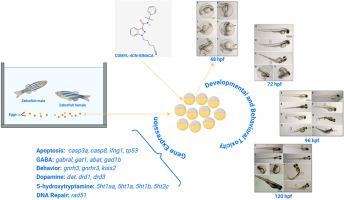Developmental toxicity and gene expression alterations induced by the synthetic cannabinoid CUMYL-4CN-BINACA in zebrafish embryos
IF 3.5
3区 医学
Q2 FOOD SCIENCE & TECHNOLOGY
引用次数: 0
Abstract
Synthetic cannabinoids like CUMYL-4CN-BINACA are emerging psychoactive substances with largely unknown developmental toxicity. Given the growing concern about prenatal and early-life exposure, this study assessed its impact on zebrafish embryos, focusing on morphological development, larval behavior, and gene expression. Embryos were exposed to concentrations of 1.25–40.0 mg/L during short-term (3–24 hpf) and long-term (3–120 hpf) windows. Key developmental endpoints, including survival, heartbeat, hatching, and locomotor activity, were evaluated. Molecular analyses were performed using qPCR to assess the expression of 19 genes related to apoptosis, behavior, and neurotransmission. Short-term exposure did not produce significant morphological changes, while long-term exposure resulted in concentration-dependent teratogenic effects such as pericardial and yolk sac edema, axial deformities, and hypoactivity. The LC50 and EC50 at 120 hpf were calculated as 16.624 mg/L and 9.083 mg/L, respectively. Gene expression analysis revealed significant alterations in behavioral genes (gnrh3, gnrhr3, kiss2), apoptotic markers (casp3a, casp8, ifng1, tp53), and the DNA repair gene rad51. Neurotransmission-related genes in dopaminergic (dat, drd1, drd3), serotonergic (5ht1aa, 5ht1a, 5ht1b, 5ht2c), and GABAergic (gabra1, gat1, abat, gad1b) systems were also dysregulated. These findings highlight the developmental and neurotoxic potential of CUMYL-4CN-BINACA, underlining the need for further toxicological risk assessments in early vertebrate models.

合成大麻素CUMYL-4CN-BINACA对斑马鱼胚胎的发育毒性和基因表达改变
合成大麻素如CUMYL-4CN-BINACA是新兴的精神活性物质,具有很大程度上未知的发育毒性。鉴于人们对产前和早期暴露的日益关注,本研究评估了其对斑马鱼胚胎的影响,重点关注形态发育、幼虫行为和基因表达。胚胎在短期(3-24 hpf)和长期(3-120 hpf)窗口暴露于1.25-40.0 mg/L的浓度中。关键的发育终点,包括生存、心跳、孵化和运动活动进行评估。采用qPCR进行分子分析,评估与细胞凋亡、行为和神经传递相关的19个基因的表达。短期暴露不产生明显的形态学改变,而长期暴露可引起浓度依赖性的致畸作用,如心包和卵黄囊水肿、轴向畸形和活动能力低下。120 hpf时LC50和EC50分别为16.624 mg/L和9.083 mg/L。基因表达分析显示,行为基因(gnrh3、gnrhr3、kiss2)、凋亡标记基因(casp3a、casp8、ifng1、tp53)和DNA修复基因rad51发生了显著变化。多巴胺能(dat、drd1、drd3)、血清素能(5ht1aa、5ht1a、5ht1b、5ht2c)和gaba能(gabra1、gat1、abat、gad1b)系统中的神经传递相关基因也出现了异常。这些发现强调了CUMYL-4CN-BINACA的发育和神经毒性潜力,强调了在早期脊椎动物模型中进一步进行毒理学风险评估的必要性。
本文章由计算机程序翻译,如有差异,请以英文原文为准。
求助全文
约1分钟内获得全文
求助全文
来源期刊

Food and Chemical Toxicology
工程技术-毒理学
CiteScore
10.90
自引率
4.70%
发文量
651
审稿时长
31 days
期刊介绍:
Food and Chemical Toxicology (FCT), an internationally renowned journal, that publishes original research articles and reviews on toxic effects, in animals and humans, of natural or synthetic chemicals occurring in the human environment with particular emphasis on food, drugs, and chemicals, including agricultural and industrial safety, and consumer product safety. Areas such as safety evaluation of novel foods and ingredients, biotechnologically-derived products, and nanomaterials are included in the scope of the journal. FCT also encourages submission of papers on inter-relationships between nutrition and toxicology and on in vitro techniques, particularly those fostering the 3 Rs.
The principal aim of the journal is to publish high impact, scholarly work and to serve as a multidisciplinary forum for research in toxicology. Papers submitted will be judged on the basis of scientific originality and contribution to the field, quality and subject matter. Studies should address at least one of the following:
-Adverse physiological/biochemical, or pathological changes induced by specific defined substances
-New techniques for assessing potential toxicity, including molecular biology
-Mechanisms underlying toxic phenomena
-Toxicological examinations of specific chemicals or consumer products, both those showing adverse effects and those demonstrating safety, that meet current standards of scientific acceptability.
Authors must clearly and briefly identify what novel toxic effect (s) or toxic mechanism (s) of the chemical are being reported and what their significance is in the abstract. Furthermore, sufficient doses should be included in order to provide information on NOAEL/LOAEL values.
 求助内容:
求助内容: 应助结果提醒方式:
应助结果提醒方式:


